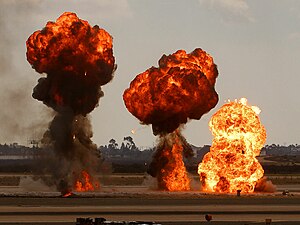
Back Дефлаграция Bulgarian Deflagració Catalan Deflagrace Czech Deflagration German Deflagración Spanish Déflagration French Deflagrazione Italian Deflagracija Lithuanian Deflagratie Dutch Deflagrasjon NB

Deflagration (Lat: de + flagrare, 'to burn down') is subsonic combustion in which a pre-mixed flame propagates through an explosive or a mixture of fuel and oxidizer.[1][2] Deflagrations in high and low explosives or fuel–oxidizer mixtures may transition to a detonation depending upon confinement and other factors.[3][4] Most fires found in daily life are diffusion flames. Deflagrations with flame speeds in the range of 1 m/s differ from detonations which propagate supersonically with detonation velocities in the range of km/s.[5]
- ^ O'Conner, Brian (March 27, 2023). "Explosions, Deflagrations and Detonations". National Fire Protection Association. Archived from the original on March 28, 2023. Retrieved May 31, 2023.
- ^ Handbook of Fire Protection Engineering (5 ed.). Society of Fire Protection Engineers. 2016. p. 373.
- ^ McDonough, Gordon (April 1, 2017). "What is a high explosive". Bradbury Science Museum, Los Alamos National Laboratory. Archived from the original on 2017-05-02. Retrieved May 31, 2023.
- ^ Rosas, Camilo; Davis, Scott; Engel, Derek; Middha, Prankul; van Wingerden, Kees; Mannan, M.S. (July 2014). "Deflagration to detonation transitions (DDTs): Predicting DDTs in hydrocarbon explosions". Journal of Loss Prevention in the Process Industries. 30: 263–274. doi:10.1016/j.jlp.2014.03.003. Retrieved May 31, 2023.
- ^ Handbook of Fire Protection Engineering (5 ed.). Society of Fire Protection Engineers. 2016. p. 390.
© MMXXIII Rich X Search. We shall prevail. All rights reserved. Rich X Search